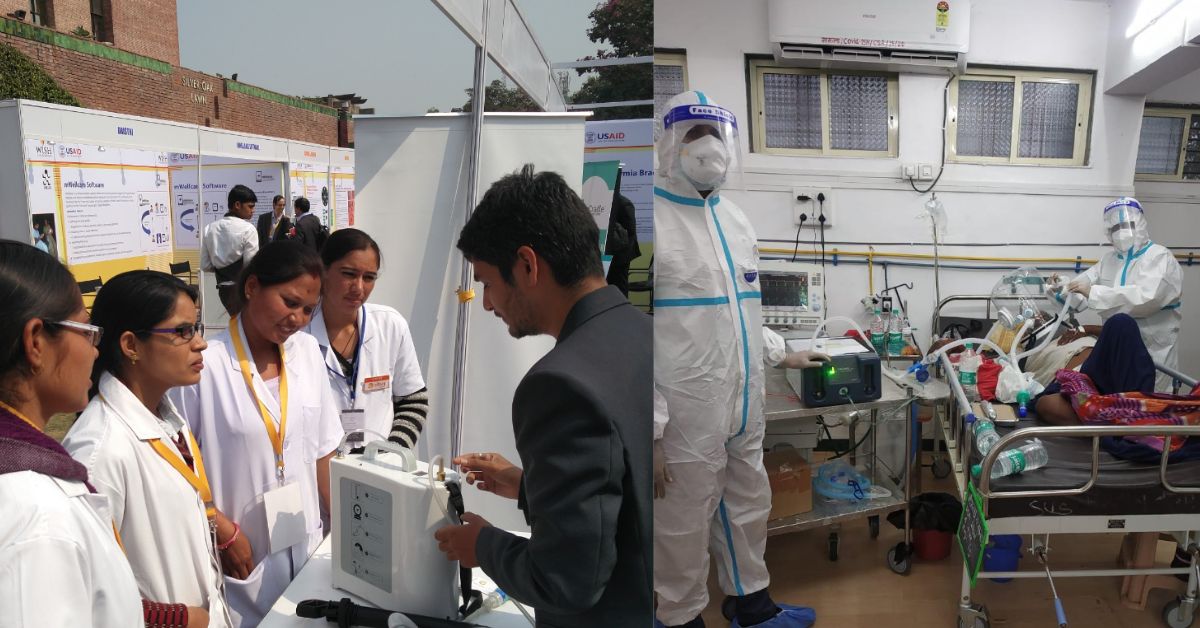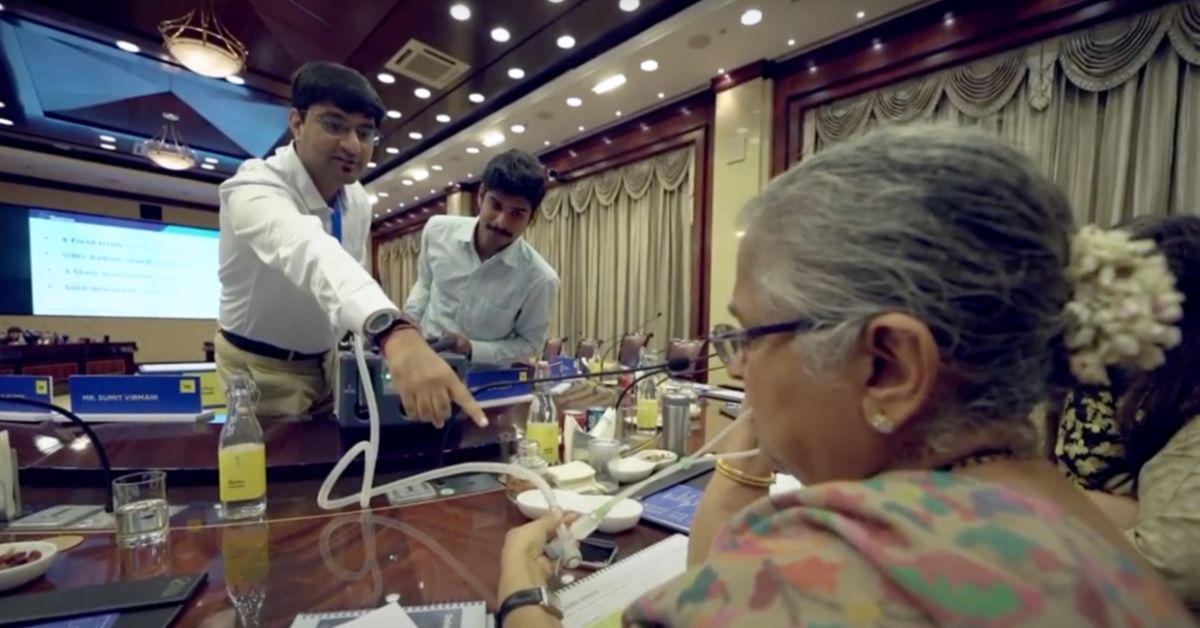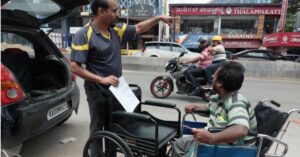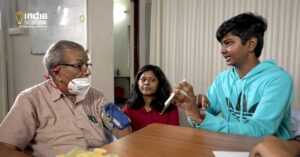How An Infosys Foundation Awardee Helps Save Infants from Premature Death
Engineer Nitesh Kumar Jangi, who won the Infosys Foundation’s Aarohan Social Innovation Awards in 2019, explains what inspired him to build Saans, an oxygen device that aims to prevent premature deaths in infants.

This article has been sponsored by Infosys Foundation.
One night in early 2015, Nitesh Kumar Jangir was at a tertiary care hospital in Bengaluru, when he saw something that shocked him.
“An infant was brought to the emergency paediatric care unit in an auto. This is Bengaluru we are speaking of. The first thought that came to my mind was, why wasn’t there a system in place for such cases to be brought to the hospital with all due medical care?”
As the doctors tried their best to revive the premature baby — who had suffered respiratory distress syndrome due to prolonged hypoxia (a low oxygen condition) — there was a scurry to set up breathing apparatus. Nine long hours later, the baby passed away.
“This wasn’t a mere mortality statistic,” notes Nitesh, who observed this entire scene unfolding. “It has a lasting impact on the families of these infants. In this case, the mother was losing a baby for the third time. The trauma can’t be imagined,” he adds.
The engineer from Rajasthan says it was this incident that gave him the idea to come up with Saans — a breathing support device that can help tackle the problem of premature deaths in babies.

‘Equal access to paediatric care’
“In the case I mentioned, the baby did not make it. But even when they do, there is a chance of brain damage. Through our research, we arrived at the conclusion that the best solution in this case is non-invasive ventilation. Fifty percent of babies who are given CPAP (continuous positive airway pressure) as the primary treatment option survive without severe issues,” notes Nitesh, who launched Saans under the startup, InnAccel Technologies.
Thus, he wondered, if a solution was so readily available, why wasn’t it being implemented? Especially given that respiratory compromise is a significant cause of the nearly 7000 newborn deaths that occur every day globally.
Further probing helped him understand that existing solutions developed by international companies were prevalent but only in centres that had well equipped NICUs (neonatal intensive care units). These were fundamentally designed for well-equipped, well-staffed, tertiary-care hospitals. This assumption was the problem, notes Nitesh, adding that in India, most births happen in smaller, often rural hospitals, where such devices could not be deployed.
In order to develop Saans, Nitesh and his team at InnAccel began looking at existing devices that helped babies breathe and what they required. They observed that existing technologies required compressed air at high pressure, a continuous supply of high pressure, high flow oxygen, a complex blender, a continuous supply of electricity, custom tubing and interfaces,, and highly trained professionals. Furthermore, these existing devices could offer only one type of non-invasive therapy and could not be used in transport.
“We designed a device that can work on any oxygen source, has a six-hour battery backup, and can work in hospital settings as well as transport. Our device does not need constant intervention; once the flow, pressure and oxygen percent are set, the machine takes care of everything and the paramedic does not need to check the parameters, due the monitoring and alarm capability in the device” he adds.
Fourteen prototypes and numerous redesigns later, Nitesh and his team had their final product ready. However, they are still building and scaling up in a bid to incorporate any feedback they may receive.
Today, over 1,000 Saans devices are being used in hospitals across India, in both urban as well as rural settings. “Our goal is that whether it is someone in a top-notch hospital or someone in a rural setting, everyone has equal access to quality healthcare,” notes Nitesh.

An idea born out of personal observations
Even while the baby incident was the final push for Nitesh to come up with Saans, coming up with medical technology was always a cause close to his heart.
Describing his growing years in a village in Rajasthan, he explains, “The nearest emergency medical service was 120 km away in Jaipur and the roads, too, were not good. People who needed to access specialised care had to travel for hours and would often lose their lives due to lack of timely care.”
Nitesh adds that these observations sowed the seeds for a love of medicine in him.
“I grew up wanting to be a doctor and serve people. I loved Biology and even gave my medical entrance exam, but when I did not clear, I took up engineering.”
Nitesh went on to pursue a course in bio-design, wherein engineers and doctors were trained on how to work together to come up with tech suitable for Indian settings. After this, as part of the training programme, he was required to spend time in various hospitals conducting need-based observational analysis.
“We would note why diabetic patients needed to undergo amputation, why persons in ICU would recover from the primary infection but then get a secondary infection and die, etc. We would then come up with solutions for these problems,” he says.
All of these learnings inspired his development of Saans, but as Nitesh says, it was support from the Government of India (through BIRAC),C-CAMP and organizations like USAID, BMGF IFC, ASME, IPE Global and Infosys Foundation, that allowed them to actually develop and build the device.
‘After the Aarohan awards, we started getting recognition.’
The Rs 10 lakh funding that Nitesh secured from the Infosys Foundation’s Aarohan Social Innovations Awards in 2019 not only set the stage for future scaling up and research, but also gave them tremendous recognition.
“I still remember the evening I received the email notifying me that I was a winner. My mom was even happier than I, as she’d read Sudha Murty’s books and was excited that I would be receiving an award from Infosys,” he says, adding that the process that an idea went through before winning was fascinating.

“Right from starting to apply to getting support from third parties and the jury, everything is great. Even if one does not win, going through the journey is an experience in itself. The funding was good, but what was more empowering was the acknowledgement we received following the award,” says Nitesh.
He adds that when they approach hospitals or NGOs and mention the Infosys Foundation’s Aarohan award, people have faith in their innovation. “This is wonderful, as being startups, we face the challenge of trust. When there are so many devices available in the market, people’s common question is ‘Why should we buy yours?’”
But with the award and how it helped them scale, their device has been used by 30,000 patients in 21 states, including a deployment in every government special newborn care unit in Assam, Nitesh says. If you found our stories insightful, informative, or even just enjoyable, we invite you to consider making a voluntary payment to support the work we do at The Better India. Your contribution helps us continue producing quality content that educates, inspires, and drives positive change. Choose one of the payment options below for your contribution- By paying for the stories you value, you directly contribute to sustaining our efforts focused on making a difference in the world. Together, let’s ensure that impactful stories continue to be told and shared, enriching lives and communities alike. Thank you for your support. Here are some frequently asked questions you might find helpful to know why you are contributing?

“In terms of scaling, we are now planning on breaking into the international market. We not only want to have a made-in-India product, but one that can be taken to the world. Sometimes we take things for granted, but those who do not have access know how tough it is,” he says.
Edited by Divya Sethu
This story made me
-
97
-
121
-
89
-
167

















